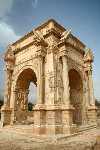 The word diwali means “a row or cluster of lights,” and the week-long festivities are illuminated by lamps, fireworks, and bonfires. In northern India, it marks the beginning of the Hindu New Year. In the Punjab and Mauritius, Diwali celebrates the coronation of Rama after his conquest of Ravana. The Jains commemorate the death of their great hero, Mahavira, on this day in the city of Pava in Bihar. Diwali is as important to Hindus as Christmas is to Christians. It is celebrated by the world’s 500 million Hindus with gift exchanges, fireworks, and festive (typically vegetarian) meals. Discuss
The word diwali means “a row or cluster of lights,” and the week-long festivities are illuminated by lamps, fireworks, and bonfires. In northern India, it marks the beginning of the Hindu New Year. In the Punjab and Mauritius, Diwali celebrates the coronation of Rama after his conquest of Ravana. The Jains commemorate the death of their great hero, Mahavira, on this day in the city of Pava in Bihar. Diwali is as important to Hindus as Christmas is to Christians. It is celebrated by the world’s 500 million Hindus with gift exchanges, fireworks, and festive (typically vegetarian) meals. Discuss
Source: The Free Dictionary
Some 16,000 years ago a big cat died. Today, its toes may provide insight into its species’ extinction. The cave lion, Panthera spelaea, once roamed from Europe to northern North America. Scientists think the animal was much like its modern African counterpart … Discuss
 According to the traditional account, Luther posted his Ninety-Five Theses on the door of the castle church in Wittenberg, Germany—an event now seen as the beginning of the Protestant Reformation. Written in response to the selling of indulgences to pay for the rebuilding of St. Peter’s Basilica in Rome, the theses represented an implicit criticism of papal policy and aroused much controversy. What formal title did Luther give the Ninety-Five Theses?
According to the traditional account, Luther posted his Ninety-Five Theses on the door of the castle church in Wittenberg, Germany—an event now seen as the beginning of the Protestant Reformation. Written in response to the selling of indulgences to pay for the rebuilding of St. Peter’s Basilica in Rome, the theses represented an implicit criticism of papal policy and aroused much controversy. What formal title did Luther give the Ninety-Five Theses?  When
When  After appearing in minor roles on TV, Landon made his film debut in 1957’s I Was a Teenage Werewolf. He endeared himself to audiences as Little Joe in the western series Bonanza (1959-1973) and later as Charles Ingalls in the series based on Laura Ingalls Wilder’s Little House on the Prairie. He also sometimes wrote and directed episodes for the shows in which he acted, including Highway to Heaven. A prankster, Landon put what reptile in his mouth to get a laugh?
After appearing in minor roles on TV, Landon made his film debut in 1957’s I Was a Teenage Werewolf. He endeared himself to audiences as Little Joe in the western series Bonanza (1959-1973) and later as Charles Ingalls in the series based on Laura Ingalls Wilder’s Little House on the Prairie. He also sometimes wrote and directed episodes for the shows in which he acted, including Highway to Heaven. A prankster, Landon put what reptile in his mouth to get a laugh?  Leptis Magna was a prominent city of the Roman Empire whose remains are among the most spectacular and best-preserved Roman ruins in North Africa. Located on the coast of what is now Libya, Leptis Magna was incorporated into the Roman Empire after the fall of Carthage, flourished under the rule of Emperor Septimius Severus—a Leptis Magna native—and eventually became a major trading post. What ancient artifacts found near the site were kept hidden for five years before being revealed in 2005?
Leptis Magna was a prominent city of the Roman Empire whose remains are among the most spectacular and best-preserved Roman ruins in North Africa. Located on the coast of what is now Libya, Leptis Magna was incorporated into the Roman Empire after the fall of Carthage, flourished under the rule of Emperor Septimius Severus—a Leptis Magna native—and eventually became a major trading post. What ancient artifacts found near the site were kept hidden for five years before being revealed in 2005?  She might hate me, and revile me, and heap indignity after indignity upon me, as she already had, until I should have hated her; but the pitiful fact remained that I loved her.
She might hate me, and revile me, and heap indignity after indignity upon me, as she already had, until I should have hated her; but the pitiful fact remained that I loved her.  “Tsar Bomba” was the nickname of a hydrogen bomb detonated by the Soviet Union in 1961 that remains the most powerful nuclear weapon ever detonated. The bomb had a yield of 50 megatons, a force equivalent to 1,400 times the combined power of the two nuclear weapons dropped on Hiroshima and Nagasaki in World War II—or approximately 1.4 percent of the power output of the Sun. The resulting seismic shock was measurable even on its third passage around the Earth. Where was Tsar Bomba detonated?
“Tsar Bomba” was the nickname of a hydrogen bomb detonated by the Soviet Union in 1961 that remains the most powerful nuclear weapon ever detonated. The bomb had a yield of 50 megatons, a force equivalent to 1,400 times the combined power of the two nuclear weapons dropped on Hiroshima and Nagasaki in World War II—or approximately 1.4 percent of the power output of the Sun. The resulting seismic shock was measurable even on its third passage around the Earth. Where was Tsar Bomba detonated?  The word diwali means “a row or cluster of lights,” and the week-long festivities are illuminated by lamps, fireworks, and bonfires. In northern India, it marks the beginning of the Hindu New Year. In
The word diwali means “a row or cluster of lights,” and the week-long festivities are illuminated by lamps, fireworks, and bonfires. In northern India, it marks the beginning of the Hindu New Year. In